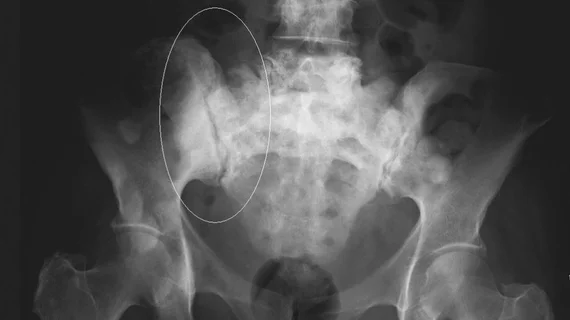18F-fluoride PET/CT accurate, reliable for detecting bone metastases
Radiolabeled 18F-fluoride PET/CT proved superior at detecting bone metastases (BM) than a comparative radiotracer, according to a Jan. 14 study published in Clinical Radiology.
“Early detection of BM is crucial for tumor staging, treatment decision, and therapy efficacy monitoring,” wrote Y. Liu, of Nanjing Medical University in Jiangsu, China, and colleagues. “At present, there are a variety of imaging methods available to detect BM…but there is no conclusion as to which method is the best as each of them has its own advantages and shortcomings.”
The authors analyzed 20 articles consisting of 1,349 patients. When uncertain results were considered negative for BM in patients, the pooled sensitivity and specificity of 18F-fluoride PET/CT were 93 percent and 95 percent, respectively; when considered positive, those numbers were 96 percent and 93 percent.
When accounting for lesions, pooled sensitivity and specificity for unequivocal negative results were 93 percent and 96 percent, respectively; when considered positive, those figures were 94 percent and 95 percent, respectively.
“Whether equivocal outcomes were considered as positive or negative, the present meta-analysis has shown that 18F-fluoride PET/CT has high pooled sensitivity and specificity both on a patient basis and a lesion basis, which is consistent with the results of most clinical trials,” the authors wrote.
Seven articles analyzed by the team compared 18F-fluoride PET/CT to 99mTc-methylene diphosphonate (MDP) planar bone scintigraphy (BS)—the current standard used for diagnosing, staging and monitoring BM.
Those studies found 8F-fluoride PET/CT achieved higher sensitivity and specificity when questionable results were labeled positive, and higher sensitivity, but no notable difference in specificity, when those results were considered negative.
The authors noted their study had several limitations, including a lack of a fully unified standard reference in bone biopsies, which may have increased the diversity of results.
“In conclusion, the present meta-analysis demonstrated the superior diagnostic performance of 18F-fluoride PET/CT in the detection of BM on both a patient and lesion basis,” the team concluded. “Besides, 18F-fluoride PET/CT showed both higher sensitivity and higher specificity as well as less equivocal results when compared with 99mTc-MDP BS, indicating that 18F-fluoride PET/CT is a more reliable method for detecting BM.”

